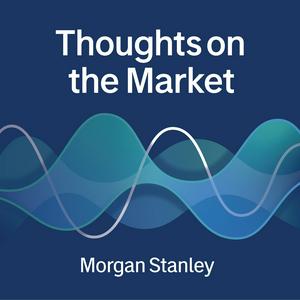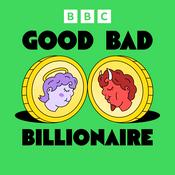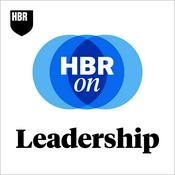1532 episodios

Special Encore: Who’s Disrupting — and Funding — the AI Boom
29/12/2025 | 14 min
Original Release Date: November 13, 2025Live from Morgan Stanley’s European Tech, Media and Telecom Conference in Barcelona, our roundtable of analysts discusses tech disruptions and datacenter growth, and how Europe factors in.Read more insights from Morgan Stanley.----- Transcript -----Paul Walsh: Welcome to Thoughts on the Market. I'm Paul Walsh, Morgan Stanley's European Head of Research Product. Today we return to my conversation with Adam Wood. Head of European Technology and Payments, Emmet Kelly, Head of European Telco and Data Centers, and Lee Simpson, Head of European Technology. We were live on stage at Morgan Stanley's 25th TMT Europe conference. We had so much to discuss around the themes of AI enablers, semiconductors, and telcos. So, we are back with a concluding episode on tech disruption and data center investments. It's Thursday the 13th of November at 8am in Barcelona. After speaking with the panel about the U.S. being overweight AI enablers, and the pockets of opportunity in Europe, I wanted to ask them about AI disruption, which has been a key theme here in Europe. I started by asking Adam how he was thinking about this theme. Adam Wood: It’s fascinating to see this year how we've gone in most of those sectors to how positive can GenAI be for these companies? How well are they going to monetize the opportunities? How much are they going to take advantage internally to take their own margins up? To flipping in the second half of the year, mainly to, how disruptive are they going to be? And how on earth are they going to fend off these challenges? Paul Walsh: And I think that speaks to the extent to which, as a theme, this has really, you know, built momentum. Adam Wood: Absolutely. And I mean, look, I think the first point, you know, that you made is absolutely correct – that it's very difficult to disprove this. It's going to take time for that to happen. It's impossible to do in the short term. I think the other issue is that what we've seen is – if we look at the revenues of some of the companies, you know, and huge investments going in there. And investors can clearly see the benefit of GenAI. And so investors are right to ask the question, well, where's the revenue for these businesses? You know, where are we seeing it in info services or in IT services, or in enterprise software. And the reality is today, you know, we're not seeing it. And it's hard for analysts to point to evidence that – well, no, here's the revenue base, here's the benefit that's coming through. And so, investors naturally flip to, well, if there's no benefit, then surely, we should focus on the risk. So, I think we totally understand, you know, why people are focused on the negative side of things today. I think there are differences between the sub-sectors. I mean, I think if we look, you know, at IT services, first of all, from an investor point of view, I think that's been pretty well placed in the losers’ buckets and people are most concerned about that sub-sector… Paul Walsh: Something you and the global team have written a lot about. Adam Wood: Yeah, we've written about, you know, the risk of disruption in that space, the need for those companies to invest, and then the challenges they face. But I mean, if we just keep it very, very simplistic. If Gen AI is a technology that, you know, displaces labor to any extent – companies that have played labor arbitrage and provide labor for the last 20 - 25 years, you know, they're going to have to make changes to their business model. So, I think that's understandable. And they're going to have to demonstrate how they can change and invest and produce a business model that addresses those concerns. I'd probably put info services in the middle. But the challenge in that space is you have real identifiable companies that have emerged, that have a revenue base and that are challenging a subset of the products of those businesses. So again, it's perfectly understandable that investors would worry. In that context, it's not a potential threat on the horizon. It's a real threat that exists today against certainly their businesses. I think software is probably the most interesting. I'd put it in the kind of final bucket where I actually believe… Well, I think first of all, we certainly wouldn't take the view that there's no risk of disruption and things aren't going to change. Clearly that is going to be the case. I think what we'd want to do though is we'd want to continue to use frameworks that we've used historically to think about how software companies differentiate themselves, what the barriers to entry are. We don't think we need to throw all of those things away just because we have GenAI, this new set of capabilities. And I think investors will come back most easily to that space. Paul Walsh: Emmet, you talked a little bit there before about the fact that you haven't seen a huge amount of progress or additional insight from the telco space around AI; how AI is diffusing across the space. Do you get any discussions around disruption as it relates to telco space? Emmet Kelly: Very, very little. I think the biggest threat that telcos do see is – it is from the hyperscalers. So, if I look at and separate the B2C market out from the B2B, the telcos are still extremely dominant in the B2C space, clearly. But on the B2B space, the hyperscalers have come in on the cloud side, and if you look at their market share, they're very, very dominant in cloud – certainly from a wholesale perspective. So, if you look at the cloud market shares of the big three hyperscalers in Europe, this number is courtesy of my colleague George Webb. He said it's roughly 85 percent; that's how much they have of the cloud space today. The telcos, what they're doing is they're actually reselling the hyperscale service under the telco brand name. But we don't see much really in terms of the pure kind of AI disruption, but there are concerns definitely within the telco space that the hyperscalers might try and move from the B2B space into the B2C space at some stage. And whether it's through virtual networks, cloudified networks, to try and get into the B2C space that way. Paul Walsh: Understood. And Lee maybe less about disruption, but certainly adoption, some insights from your side around adoption across the tech hardware space? Lee Simpson: Sure. I think, you know, it's always seen that are enabling the AI move, but, but there is adoption inside semis companies as well, and I think I'd point to design flow. So, if you look at the design guys, they're embracing the agentic system thing really quickly and they're putting forward this capability of an agent engineer, so like a digital engineer. And it – I guess we've got to get this right. It is going to enable a faster time to market for the design flow on a chip. So, if you have that design flow time, that time to market. So, you're creating double the value there for the client. Do you share that 50-50 with them? So, the challenge is going to be exactly as Adam was saying, how do you monetize this stuff? So, this is kind of the struggle that we're seeing in adoption. Paul Walsh: And Emmet, let's move to you on data centers. I mean, there are just some incredible numbers that we've seen emerging, as it relates to the hyperscaler investment that we're seeing in building out the infrastructure. I know data centers is something that you have focused tremendously on in your research, bringing our global perspectives together. Obviously, Europe sits within that. And there is a market here in Europe that might be more challenged. But I'm interested to understand how you're thinking about framing the whole data center story? Implications for Europe. Do European companies feed off some of that U.S. hyperscaler CapEx? How should we be thinking about that through the European lens? Emmet Kelly: Yeah, absolutely. So, big question, Paul. What… Paul Walsh: We've got a few minutes! Emmet Kelly: We've got a few minutes. What I would say is there was a great paper that came out from Harvard just two weeks ago, and they were looking at the scale of data center investments in the United States. And clearly the U.S. economy is ticking along very, very nicely at the moment. But this Harvard paper concluded that if you take out data center investments, U.S. economic growth today is actually zero. Paul Walsh: Wow. Emmet Kelly: That is how big the data center investments are. And what we've said in our research very clearly is if you want to build a megawatt of data center capacity that's going to cost you roughly $35 million today. Let's put that number out there. 35 million. Roughly, I'd say 25… Well, 20 to 25 million of that goes into the chips. But what's really interesting is the other remaining $10 million per megawatt, and I like to call that the picks and shovels of data centers; and I'm very convinced there is no bubble in that area whatsoever.So, what's in that area? Firstly, the first building block of a data center is finding a powered land bank. And this is a big thing that private equity is doing at the moment. So, find some real estate that's close to a mass population that's got a good fiber connection. Probably needs a little bit of water, but most importantly needs some power. And the demand for that is still infinite at the moment. Then beyond that, you've got the construction angle and there's a very big shortage of labor today to build the shells of these data centers. Then the third layer is the likes of capital goods, and there are serious supply bottlenecks there as well.And I could go on and on, but roughly that first $10 million, there's no bubble there. I'm very, very sure of that. Paul Walsh: And we conducted some extensive survey work recently as part of your analysis into the global data center market. You've sort of touched on a few of the gating factors that the industry has to contend with. That survey work was done on the operators and the supply chain, as it relates to data center build out. What were the key conclusions from that? Emmet Kelly: Well, the key conclusion was there is a shortage of power for these data centers, and… Paul Walsh: Which I think… Which is a sort of known-known, to some extent. Emmet Kelly: it is a known-known, but it's not just about the availability of power, it's the availability of green power. And it's also the price of power is a very big factor as well because energy is roughly 40 to 45 percent of the operating cost of running a data center. So, it's very, very important. And of course, that's another area where Europe doesn't screen very well.I was looking at statistics just last week on the countries that have got the highest power prices in the world. And unsurprisingly, it came out as UK, Ireland, Germany, and that's three of our big five data center markets. But when I looked at our data center stats at the beginning of the year, to put a bit of context into where we are…Paul Walsh: In Europe… Emmet Kelly: In Europe versus the rest. So, at the end of [20]24, the U.S. data center market had 35 gigawatts of data center capacity. But that grew last year at a clip of 30 percent. China had a data center bank of roughly 22 gigawatts, but that had grown at a rate of just 10 percent. And that was because of the chip issue. And then Europe has capacity, or had capacity at the end of last year, roughly 7 to 8 gigawatts, and that had grown at a rate of 10 percent. Now, the reason for that is because the three big data center markets in Europe are called FLAP-D. So, it's Frankfurt, London, Amsterdam, Paris, and Dublin. We had to put an acronym on it. So, Flap-D. Good news. I'm sitting with the tech guys. They've got even more acronyms than I do, in their sector, so well done them. Lee Simpson: Nothing beats FLAP-D. Paul Walsh: Yes. Emmet Kelly: It’s quite an achievement. But what is interesting is three of the big five markets in Europe are constrained. So, Frankfurt, post the Ukraine conflict. Ireland, because in Ireland, an incredible statistic is data centers are using 25 percent of the Irish power grid. Compared to a global average of 3 percent.Now I'm from Dublin, and data centers are running into conflict with industry, with housing estates. Data centers are using 45 percent of the Dublin grid, 45. So, there's a moratorium in building data centers there. And then Amsterdam has the classic semi moratorium space because it's a small country with a very high population. So, three of our five markets are constrained in Europe. What is interesting is it started with the former Prime Minister Rishi Sunak. The UK has made great strides at attracting data center money and AI capital into the UK and the current Prime Minister continues to do that. So, the UK has definitely gone; moved from the middle lane into the fast lane. And then Macron in France. He hosted an AI summit back in February and he attracted over a 100 billion euros of AI and data center commitments. Paul Walsh: And I think if we added up, as per the research that we published a few months ago, Europe's announced over 350 billion euros, in proposed investments around AI. Emmet Kelly: Yeah, absolutely. It's a good stat. Now where people can get a little bit cynical is they can say a couple of things. Firstly, it's now over a year since the Mario Draghi report came out. And what's changed since? Absolutely nothing, unfortunately. And secondly, when I look at powering AI, I like to compare Europe to what's happening in the United States. I mean, the U.S. is giving access to nuclear power to AI. It started with the three Mile Island… Paul Walsh: Yeah. The nuclear renaissance is… Emmet Kelly: Nuclear Renaissance is absolutely huge. Now, what's underappreciated is actually Europe has got a massive nuclear power bank. It's right up there. But unfortunately, we're decommissioning some of our nuclear power around Europe, so we're going the wrong way from that perspective. Whereas President Trump is opening up the nuclear power to AI tech companies and data centers. Then over in the States we also have gas and turbines. That's a very, very big growth area and we're not quite on top of that here in Europe. So, looking at this year, I have a feeling that the Americans will probably increase their data center capacity somewhere between – it's incredible – somewhere between 35 and 50 percent. And I think in Europe we're probably looking at something like 10 percent again. Paul Walsh: Okay. Understood. Emmet Kelly: So, we're growing in Europe, but we're way, way behind as a starting point. And it feels like the others are pulling away. The other big change I'd highlight is the Chinese are really going to accelerate their data center growth this year as well. They've got their act together and you'll see them heading probably towards 30 gigs of capacity by the end of next year. Paul Walsh: Alright, we're out of time. The TMT Edge is alive and kicking in Europe. I want to thank Emmett, Lee and Adam for their time and I just want to wish everybody a great day today. Thank you.(Applause) That was my conversation with Adam, Emmett and Lee. Many thanks again to them. Many thanks again to them for telling us about the latest in their areas of research and to the live audience for hearing us out. And a thanks to you as well for listening. Let us know what you think about this and other episodes by living us a review wherever you get your podcasts. And if you enjoy listening to Thoughts on the Market, please tell a friend or colleague about the podcast today.

Special Encore: 2026 U.S. Outlook: The Bull Market’s Underappreciated Narrative
26/12/2025 | 6 min
Original Release Date: November 19, 2025Our CIO and Chief U.S. Equity Strategist Mike Wilson explains why he continues to hold on to an out-of-consensus view of a growth positive 2026, despite near-term risks.Read more insights from Morgan Stanley.----- Transcript -----Welcome to Thoughts on the Market. I'm Mike Wilson, Morgan Stanley’s CIO and Chief U.S. Equity Strategist. Today I’ll discuss our outlook for 2026 that we published earlier this week. It’s Wednesday, Nov 19th at 6:30 am in New York. So, let’s get after it. 2026 is a continuation of the story we have been telling for the past year. Looking back to a year ago, our U.S. equity outlook was for a challenging first half, followed by a strong second half. At the time of publication, this was an out of consensus stance. Many expected a strong first half, as President Trump took office for his second term. And then a more challenging second half due to the return of inflation. We based our differentiated view on the notion that policy sequencing in the new Trump administration would intentionally be growth negative to start. We likened the strategy to a new CEO choosing to ‘kitchen sink’ the results in an effort to clear the decks for a new growth positive strategy. We thought that transition would come around mid-year. The U.S. economy had much less slack when President Trump took office the second time, compared to the first time he came into office. And this was the main reason we thought it was likely to be sequenced differently. Earnings revisions breadth and other cyclical indicators were also in a phase of deceleration at the end of 2024. In contrast, at the beginning of 2017—when we were out of consensus bullish—earnings revisions breadth and many cyclical gauges were starting to reaccelerate after the manufacturing and commodity downturn of 2015/2016. Looking back on this year, this cadence of policy sequencing did broadly play out—it just happened faster and more dramatically than we expected. Our views on the policy front still appear to be out of consensus. Many industry watchers are questioning whether policies enacted this year will ultimately lead to better growth going forward, especially for the average stock. From our perspective, the policy choices being made are growth positive for 2026 and are largely in line with our ‘run it hot’ thesis. There’s another factor embedded in our more constructive take. April marked the end of a rolling recession that began three years prior. The final stages were a recession in government thanks to DOGE, a rate of change trough in expectations around AI CapEx growth and trade policy, and a recession in consumer services that is still ongoing. In short, we believe a new bull market and rolling recovery began in April which means it’s still early days, and not obvious—especially for many lagging parts of the economy and market. That is the opportunity. The missing ingredient for the typical broadening in stock performance that happens in a new business cycle is rate cuts. Normally, the Fed would have cut rates more in this type of weakening labor market. But due to the imbalances and distortions of the COVID cycle, we think the Fed is later than normal in easing policy, and that has held back the full rotation toward early cycle winners. Ironically, the government shutdown has weakened the economy further, but has also delayed Fed action due to the lack of labor data releases. This is a near-term risk to our bullish 12-month forecasts should delays in the data continue, or lagging labor releases do not corroborate the recent weakness in non-govt-related jobs data. In our view, this type of labor market weakness coupled with the administration's desire to ‘run it hot’ means that, ultimately, the Fed is likely to deliver more dovish policy than the market currently expects. It's really just a question of timing. But that is a near-term risk for equity markets and why many stocks have been weaker recently. In short, we believe a new bull market began in April with the end of a rolling recession and bear market. Remember the S&P [500] was down 20 percent and the average S&P stock was down more than 30 percent into April. This narrative remains underappreciated, and we think there is significant upside in earnings over the next year as the recovery broadens and operating leverage returns with better volumes and pricing in many parts of the economy. Our forecasts reflect this upside to earnings which is another reason why many stocks are not as expensive as they appear despite our acknowledgement that some areas of the market may appear somewhat frothy. For the S&P 500, our 12-month target is now 7800 which assumes 17 percent earnings growth next year and a very modest contraction in valuation from today’s levels. Our favorite sectors include Financials, Industrials, and Healthcare. We are also upgrading Consumer Discretionary to overweight and prefer Goods over Services for the first time since 2021. Another relative trade we like is Software over Semiconductors given the extreme relative underperformance of that pair and positioning at this point. Finally, we like small caps over large for the first time since March 2021, as the early cycle broadening in earnings combined with a more accommodative Fed provides the backdrop we have been patiently waiting for. We hope you enjoy our detailed report published earlier this week and find it helpful as you navigate a changing marketplace on many levels. Thanks for tuning in. Let us know what you think by leaving us a review. And if you find Thoughts on the Market worthwhile, tell a friend or colleague to try it out!

Special Encore: 2026 Global Outlook: Slower Growth and Inflation
24/12/2025 | 10 min
Original Release Date: November 17, 2025In the first of a two-part episode presenting our 2026 outlooks, Chief Global Cross-Asset Strategist Serena Tang has Chief Global Economist Seth Carpenter explain his thoughts on how economies around the world are expected to perform and how central banks may respond.Read more insights from Morgan Stanley.----- Transcript -----Serena Tang: Welcome to Thoughts on the Market. I'm Serena Tang, Morgan Stanley's Chief Global Cross-Asset Strategist. Seth Carpenter: And I'm Seth Carpenter, Morgan Stanley's Global Chief Economist. Serena Tang: Today, we'll focus on [the] all-important macroeconomic backdrop. Serena Tang: It's Monday, November 17th at 10am in New York. So, Seth, 2025 has been a year of transition. Global growth slowed under the weight of tariffs and policy uncertainty. Yet resilience in consumer spending and AI driven investments kept recession fears at bay. Your team has published its economic outlook for 2026. So, what's your view on global growth for the year ahead? Seth Carpenter: We really think next year is going to be the global economy slowing down a little bit more just like it did this year, settling into a slower growth rate. But at the same time, we think inflation is going to keep drifting down in most of the world. Now that anodyne view, though, masks some heterogeneity around the world; and importantly, some real uncertainty about different ways things could possibly go. Here in the U.S., we think there is more slowing to come in the near term, especially the fourth quarter of this year and the beginning of next year. But once the economy works its way through the tariffs, maybe some of the lagged effects of monetary policy, we'll start to see things pick up a bit in the second half of the year. China's a different story. We see the really tepid growth there pushed down by the deflationary spiral they've been in. We think that continues for next year, and so they're probably not quite going to get to their 5 percent growth target. And in Europe, there's this push and pull of fiscal policy across the continent. There's a central bank that thinks they've achieved their job in terms of inflation, but overall, we think growth there is, kind of, unremarkable, a little bit over 1 percent. Not bad, but nothing to write home about at all. So that's where we think things are going in general. But I have to say next year, may well be a year for surprises. Serena Tang: Right. So where do you see the biggest drivers of global growth in 2026, and what are some of the key downside risks? Seth Carpenter: That's a great question. I really do think that the U.S. is going to be a real key driver of the story here. And in fact – and maybe we'll talk about this later – if we're wrong, there's some upside scenarios, there's some downside scenarios. But most of them around the world are going to come from the U.S. Two things are going on right now in the U.S. We've had strong spending data. We've also had very, very weak employment data. That usually doesn't last for very long. And so that's why we think in the near term there's some slowdown in the U.S. and then over time things recover. We could be wrong in either direction. And so, if we're wrong and the labor market sending the real signal, then the downside risk to the U.S. economy – and by extension the global economy – really is a recession in the U.S. Now, given the starting point, given how low unemployment is, given the spending businesses are doing for AI, if we did get that recession, it would be mild. On the other hand, like I said, spending is strong. Business spending, especially CapEx for AI; household spending, especially at the top end of the income distribution where wealth is rising from stocks, where the liability side of the balance sheet is insulated with fixed rate mortgages. That spending could just stay strong, and we might see this upside surprise where the spending really dominates the scene. And again, that would spill over for the rest of the world. What I don't see is a lot of reason to suspect that you're going to get a big breakout next year to the upside or the downside from either Europe or China, relative to our baseline scenarios. It could happen, but I really think most of the story is going to be driven in the U.S. Serena Tang: So, Seth, markets have been focused on the Fed, as it should. What is the likely path in 2026 and how are you thinking about central bank policy in general in other regions? Seth Carpenter: Absolutely. The Fed is always of central importance to most people in markets. Our view – and the market's view, I have to say, has been evolving here. Our view is that the Fed's actually got a few more rate cuts to get through, and that by the time we get to the middle of next year, the middle of 2026, they're going to have their policy rate down just a little bit above 3 percent. So roughly where the committee thinks neutral is. Why do we think that? I think the slowing in the labor market that we talked about before, we think there's something kind of durable there. And now that the government shutdown has ended and we're going to start to get regular data prints again, we think the data are going to show that job creation has been below 50,000 per month on average, and maybe even a few of them are going to get to be negative over the next several months. In that situation, we think the Fed's going to get more inclination to guard against further deterioration in the labor market by keeping cutting rates and making sure that the central bank is not putting any restraint on the economy. That's similar, I would say, to a lot of other developed markets’ central banks. But the tension for the ECB, for example, is that President Lagarde has said she thinks; she thinks the disinflationary process is over. She thinks sitting at 2 percent for the policy rate, which the ECB thinks of as neutral, then that's the right place for them to be. Our take though is that the data are going to push them in a different direction. We think there is clearly growth in Europe, but we think it's tepid. And as a result, the disinflationary process has really still got some more room to run and that inflation will undershoot their 2 percent target, and as a result, the ECB is probably going to cut again. And in our view, down to about 1.5 percent. Big difference is in Japan. Japan is the developed market central bank that's hiking. Now, when does that happen? Our best guess is next month in December at the policy meeting. We've seen this shift towards reflation. It hasn't been smooth, hasn't been perfectly linear. But the BoJ looks like they're set to raise rates again in December. But the path for inflation is going to be a bit rocky, and so, they're probably on hold for most of 2026. But we do think eventually, maybe not till 2027, they get back to hiking again – so that Governor Ueda can get the policy rate back close to neutral before he steps down. Serena Tang: So, one of the main investor debates is on AI. Whether it's CapEx, productivity, the future of work. How is that factoring into your team's view on growth and inflation for the next year? Seth Carpenter: Yeah, I mean that is absolutely a key question that we get all the time from investors around the world. When I think about AI and how it's affecting the economy, I think about the demand side of the economy, and that's where you think about this CapEx spending – building data centers, buying semiconductors, that sort of thing. That's demand in the economy. It's using up current resources in the economy, and it's got to be somewhat inflationary. It's part of what has kept the U.S. economy buoyant and resilient this year – is that CapEx spending. Now you also mentioned productivity, and for me, that's on the supply side of the economy. That's after the technology is in place. After firms have started to adopt the technology, they're able to produce either the same amount with fewer workers, or they're able to produce more with the same amount of workers. Either way, that's what productivity means, and it's on the supply side. It can mean faster growth and less inflation. I think where we are for 2026, and it's important that we focus it on the near term, is the demand side is much more important than the supply side. So, we think growth continues. It's supported by this business investment spending. But we still think inflation ends 2026, notably above the Fed's inflation target. And it's going to make five, five and a half years that we've been above target. Productivity should kick in. And we've written down something close to a quarter percentage point of extra productivity growth for 2026, but not enough to really be super disinflationary. We think that builds over time, probably takes a couple of years. And for example, if we think about some of the announcements about these data centers that are being built, where they're really going to unleash the potential of AI, those aren't going to be completed for a couple of years anyway. So, I think for now, AI is dominating the demand side of the economy. Over the next few years, it's going to be a real boost to the supply side of the economy. Serena Tang: So that makes a lot of sense to me, Seth. But can you put those into numbers? Seth Carpenter: Sure, Serena totally. In numbers, that's about 3 percent growth. A little bit more than that for global GDP growth on like a Q4-over-Q4 basis. But for the U.S. in particular, we've got about 1.75 percent. So that's not appreciably different from what we're looking for this year in 2025. But the number really, kind of, masks the evolution over time. We think the front part of the year is going to be much weaker. And only once we get into the second half of next year will things start to pick up. That said, compared to where we were when we did the midyear outlook, it's actually a notable upgrade. We've taken real signal from the fact that business spending, household spending have both been stronger than we think. And we've tried to add in just a little bit more in terms of productivity growth from AI. Layer on top of that, the Fed who's been clearly willing to start to ease interest rates sooner than we thought at the time of the mid-year outlook – all comes together for a little bit better outlook for growth for 2026 in the U.S. Serena Tang: Seth thanks so much for taking the time to talk. Seth Carpenter: Serena, it is always my pleasure to get to talk to you. Serena Tang: And thanks for listening. Please be sure to tune into the second half of our conversation tomorrow to hear how we're thinking about investment strategy in the year ahead. If you enjoy Thoughts on the Market, please leave us a review wherever you listen and share the podcast with a friend or colleague today.

Will the Data Center Boom Impact Your Wallet?
23/12/2025 | 10 min
Our Thematic and Equity Strategist Michelle Weaver and Power, Utilities, and Clean Tech Analyst David Arcaro discuss how investments in AI data centers are affecting electricity bills for U.S. consumers.Read more insights from Morgan Stanley.----- Transcript -----Michelle Weaver: Welcome to Thoughts on the Market. I'm Michelle Weaver, Morgan Stanley's U.S. Thematic and Equity Strategist.David Arcaro: And I'm Dave Arcaro, U.S. Power, Utilities, and Clean Tech Analyst.Michelle Weaver: Today, a hot topic. Are data centers’ raising your electricity bills?It's Tuesday, December 23rd at 10am in New York.Most of us have probably noticed our electricity bills have been creeping up. And it's putting pressure on U.S. consumers, especially with higher prices and paychecks not keeping pace. More and more people are pointing to data centers as the reason behind these rising costs, but the story isn't that simple.Regional differences, shifting policies and local utility responses are all at play here. Dave, there's no doubt that data centers are becoming a much bigger part of the story when it comes to U.S. electricity demand. For listeners who might not follow these numbers every day, could you break down how data centers' share of overall electricity use is expected to grow over the next 10 years? And what does that mean for the grid and for the average consumer?David Arcaro: Definitely they're becoming much bigger, much more important and more impactful across the industry in a big way. Data centers were 6 percent of total electricity consumption in the U.S. last year. We're actually forecasting that to triple to 18 percent by 2030, and then hit 20 percent in the early 2030s. So very strong growth, and increasing proportion of the overall utility, electricity use.In aggregate, this is reflecting about 150 gigawatts of new data centers by 2030. Just a very large amount. And this is going to cause a major strain on the electric grid and is going to require substantial build out and upgrading of the transmission system along with construction of new power generation – like gas plants and large-scale renewables, wind, solar, and battery storage across the entire U.S.And generally, when we see utilities investing in additional infrastructure, they need to get that cost recovered. We would typically expect that to lead to higher electric rates for consumers. That's the overall pressure that we're facing right now on the system, from all these data centers coming in.We've got these substantial infrastructure needs. That means utilities will need to charge higher prices to consumers to cover the cost of those investments.Michelle Weaver: What are the main challenges utilities companies face in meeting this rising demand from data centers?David Arcaro: There are a number of challenges. If I were to pick a few of the biggest ones that I see, I think managing affordability is one of the biggest challenges the industry faces right now, because this overall data center growth is absolutely a shock to their business, and it needs to be managed carefully given the political and regulatory challenges that can arise when customer bills are getting are escalating faster than expected. The utility industry faces scrutiny and constant attention from a political and regulatory standpoint, so it's a balance that has to be very carefully managed. There are also reliability challenges that are important.Utilities have to keep the lights on, you know, that's priority number one. The demand for electricity is growing much faster than the supply of new generation that we're seeing; new power plants just aren't being built fast enough. New transmission assets are not being built, as quickly as the data centers are coming on. So, in many areas we're seeing that leads to essentially less of a buffer, and more risk of outages during periods of extreme weather.Michelle Weaver: And you mentioned, companies are thinking about how can they insulate consumers. Can you take us through some of the specifics of what these utility companies are doing? And what regulators are doing to respond, to protect existing customers from rate increases driven by data centers?David Arcaro: Definitely. The industry is getting creative and trying to be proactive in addressing this issue. Many utilities, we're seeing them isolate data centers and charge them higher electric rates, specifically for those data center customers to try to cover all of the grid costs that are attributable to the data center's needs.A couple examples. In Indiana, we're seeing that there's a utility there who's building new power plants, specifically for a very large data center that's coming into the state and they're ring fencing it. They're only charging the data center itself for those costs of the power plants. In Georgia, a utility there is charging a higher rate for the data centers that are coming in to the Atlanta area – such that it actually more than covers the costs and compensates other consumers in the form of bill credits or even bill reductions as those data centers come on.Similarly, then, in Pennsylvania, there's a utility that has excess transmission infrastructure than the state’s [infrastructure]. They're better able to absorb data center activity. They're able to lower customer bills as the data centers come on, as they spread their costs over a larger customer base in that case. So, this isn't universal though. There are some areas around the country where there are costs related to data center growth that get socialized across all consumers.One approach I also wanted to mention that we're seeing data centers pursue more and more actively is to power themselves. Essentially bring their own power, and they're using gas turbines, engines, and fuel cells that they're deploying right on site. This is actually in many cases faster than connecting to the grid, but it also avoids any consumer impact. Companies like Solaris Energy and Bloom Energy are two providers of that type of solution. And we're also seeing at a broader industry level. Another approach is the idea of data centers being flexible or turning off and not consuming power from the grid at certain times when the grid is facing stress, in an extreme weather scenario in the winter or summer. And that idea is gaining traction as well. So, we think the industry is looking for approaches that could ease the pressure on the system and on reliability, manage the affordability issues while continuing to enable and build data centers.Michelle Weaver: You mentioned what a few different states are doing on this front. But data centers are not evenly distributed through states or evenly distributed across regions. Are there regional differences in how data center growth is impacting electricity prices?David Arcaro: There are a couple of key differences that we're seeing around the country. Some areas just aren't getting that many data centers, you know, so I'd point out the northeast – in New England, in New York, we're just not seeing that much data center growth. So, it's less of an issue, the impact of data center power demand impacting customer bills in those areas. And then in some regions around the country, the utility structure is important to be aware of. There are some regions where the price of electricity fluctuates based on the supply and demand of power, rather than being directly set and controlled by a regulator. In those markets, data centers can actually more directly impact the price of electricity and there just isn't an easy way in that case to ring fence them and protect consumers from the impact of price increases.So that's where we think unique challenges can arise. And over time, we would expect to see the most meaningful rate impacts to consumers in those areas specifically. And examples would be New Jersey, Maryland, Illinois, Pennsylvania, Ohio. Those are a couple of the states where we're seeing those more volatile and directly impacted prices.So, as we look at utilities, we think the state exposure is going to be more and more important. And so, a few companies like NextEra, Sempra and AEP are a few utilities that are in states that have less affordability concerns and less direct exposure to rate impacts from data centers. And then several power companies like Vistra and Talen have more of their power plants that are in states that have excess infrastructure; and as a result, potentially less affordability concerns.So, clearly the energy sector is facing real challenges and changes. So, Michelle, how are rising electricity bills actually affecting U.S. households?Michelle Weaver: It's putting even more pressure on a consumer that's already being stretched thin by multiple years of inflation and elevated price levels, and electricity is a really different type of good. It's very different from gasoline or other consumer goods or staples – in that it's an essential good. You need to have it. And it's a network service that households are structurally locked into. Unlike gas where you could adjust your trip frequency or take a different type of transport, there really aren't good substitutes for electricity.And so this dynamic weighs on consumers. They have to continue paying these bills, and it weighs particularly heavily on lower income consumers where utility bills make up a much larger portion of their household budget.So, it crowds out some of that other potential spending.David Arcaro: That makes a lot of sense. It's an important expense to consider in terms of the impact on consumers. And, you know, as a result, are consumers blaming data center electricity demand for this rise that we're seeing in bills or are they pushing back?Michelle Weaver: Yeah. Data center development is quickly becoming a NIMBY or “not in my backyard” issue with communities pushing back and even getting projects canceled. Companies really need to find ways to address local concerns about environmental and water related externalities. And message that they're able to insulate consumers, or do something to mitigate these potentially higher electricity bills.A recent poll of around 2200 voters found that just over half of respondents attribute overall electricity price increases to AI data centers, at least somewhat. While around another third, consider them very responsible. And these responses are consistent across all regions and across political affiliations. And I think this consistency across regions is really interesting. As we're talking about before, data centers are not impacting bills in every region. But consumers are still blaming them and still attributing bill increases there.It’s clear that both the energy sector and U.S. consumers are navigating a complex landscape with data center growth at the center of the conversation. As policy responses evolve and the U.S. midterm elections approach, this issue is only going to gain more attention. And we'll be sure to bring you the latest. Dave, thanks for taking the time to talk.David Arcaro: Great speaking with you, Michelle.Michelle Weaver: And thanks for listening. If you enjoy Thoughts on the Market, please leave us a review wherever you listen and share the podcast with a friend or colleague today.

Rebalancing Portfolios as Risk Premiums Drop
22/12/2025 | 5 min
Our Chief Cross-Asset Strategist Serena Tang discusses how current market conditions are challenging traditional investment strategies and what that means for asset allocation.Read more insights from Morgan Stanley.----- Transcript -----Welcome to Thoughts on the Market. I’m Serena Tang, Morgan Stanley’s Chief Cross-Asset Strategist.Today – does the 60/40 portfolio still make sense, and what can investors expect from long-term market returns?It’s Monday, December 22nd at 10am in New York.Global equities have rallied by more than 35 percent from lows made in April. And U.S. high grade fixed income has seen the last 12 months’ returns reach 5 percent, above the averages over the last 10 years. This raises important questions about future returns and how investors might want to adapt their portfolios.Now, our work shows that long-run expected returns for equities are lower than in previous decades, while fixed income – think government bonds and corporate bonds – still offers relatively elevated returns, thanks to higher yields.Let’s put some numbers to it. Over the next decade, we project global equities to deliver an annualized return of nearly 7 percent, with the S&P 500 just behind at 6.8 percent. European and Japanese equities stand out, potentially returning about 8 percent. Emerging markets, however, lag at just about 4 percent. On the bond side, we think U.S. Treasuries with a 10-year maturity will return nearly 5 percent per year, German Bunds nearly 4 [percent], and Japanese government bonds nearly 2 [percent]. They may sound low, but it’s all above their long-run averages.But here’s where it gets interesting. The extra return you get for taking on risk – what we call the risk premium – has compressed across the board. In the U.S., the equity risk premium is just 2 percent. And for emerging markets, it’s actually negative at around -1 percent. In very plain terms, investors aren’t being paid as much for taking on risk as they used to be.Now, why is this the case? It’s because valuations are rich, especially in the U.S. But we also need to put these valuations in context. Yes, the S&P 500’s cyclically adjusted price-to-earnings ratio is near the highest level since the dotcom bubble. But the quality of the S&P 500 has improved dramatically over the past few decades. Companies are more profitable, and free cash flow -- money left after expenses -- is almost three times higher than it was in 2000. So, while valuations are rich, there’s some justification for it.The lower risk premiums for stocks and credits, regardless of whether we think they are justified or not, has very interesting read across for investors’ multi-asset portfolios. The efficient frontier – meaning the best possible return for any given level of portfolio risk – has shifted. It’s now flatter and lower than in previous years. So, it means taking on more risk in a portfolio right now won’t necessarily boost returns as much as before.Now, let’s turn our attention to the classic 60/40 portfolio – the mix of 60 percent stocks and 40 percent bonds that’s been a staple strategy for generations. After a tough 2022, this strategy has bounced back, delivering above-average returns for three years in a row. Looking ahead, though, we expect only around 6 percent annual returns for a 60/40 portfolio over the next decade versus around 9 percent average return historically. Importantly though, advances in AI could keep stocks and bonds moving more in sync than they used to be. If that happens, investors might benefit from increasing their equity allocation beyond the traditional 60/40 split.Either way, it’s important to realize that the optimal mix of stocks and bonds is not static and should be revisited as market dynamics evolve.In a world where risk assets feel expensive and the old rules don’t quite fit, it’s essential to understand how risk, return, and correlation work together. This will help you navigate the next decade. The 60/40 portfolio isn’t dead – and optimal multi-asset allocation weights are evolving. And so should you.Thanks for listening. If you enjoy the show, please leave us a review wherever you listen and share Thoughts on the Market with a friend or colleague today.
Más podcasts de Economía y empresa
Podcasts a la moda de Economía y empresa
Acerca de Thoughts on the Market
Escucha Thoughts on the Market, El Podcast de Marc Vidal y muchos más podcasts de todo el mundo con la aplicación de radio.es

Descarga la app gratuita: radio.es
- Añadir radios y podcasts a favoritos
- Transmisión por Wi-Fi y Bluetooth
- Carplay & Android Auto compatible
- Muchas otras funciones de la app
Descarga la app gratuita: radio.es
- Añadir radios y podcasts a favoritos
- Transmisión por Wi-Fi y Bluetooth
- Carplay & Android Auto compatible
- Muchas otras funciones de la app


Thoughts on the Market
Descarga la app,
Escucha.







































